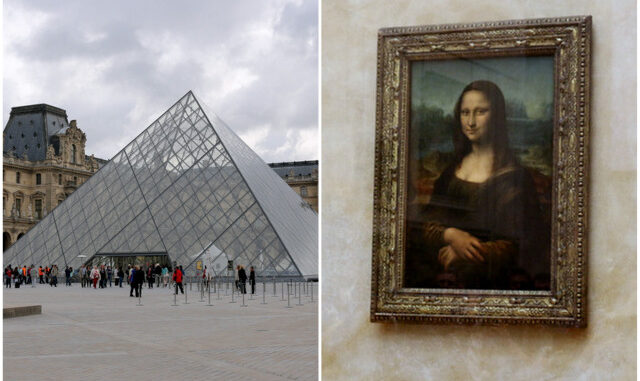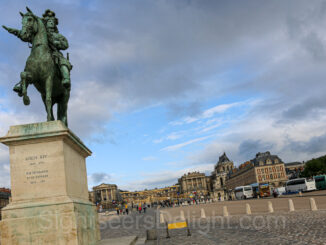
PARIS — The face is instantly recognizable: The woman, probably in her 20s or 30s, looks toward the viewer with an almost emotionless expression.
Is she smirking? Who is she? Why is she looking directly at the viewer?
Questions abound, yet the Mona Lisa — or La Gioconda, as the painting is known in Italian — is probably the most famous painting in the world. Painted in the early 16th century by Italian artist Leonardo da Vinci, the Mona Lisa is today instantly recognizable even to people who know nothing about art.
“There exists no particular reason or piece of evidence to determine unequivocally why Leonardo da Vinci’s portrait of a woman, commonly known as the Mona Lisa, is indeed among the most famous in the history of western art,” Dr. Erin E. Benay assistant professor of Renaissance and Baroque Art at Case Western Reserve University in Cleveland, Ohio. “In some ways the picture is quite unremarkable: It is small in scale, muted in color due to Leonardo’s use of sfumato — a glazing process that creates a smoky haze — and ambiguous in its geographic setting.”
Many historians believe the painting is a portrait of Florentine resident Lisa del Giocondo (nee Gherardini). The Mona Lisa remains on display in Paris’ famous Musee du Louvre, the same location the painting has called home since 1797, except for a few times when the painting has toured the world or when it was stolen in the early 20th century.
The nearly photographic quality of this painting — a quality seen in other da Vinci works — could provide one explanation of the painting’s enduring fame.
“Niccolò Machiavelli had a baby boy while Leonardo was working in Florence. His friend writes to him: ‘He looks just like you! As if Leonardo had painted your portrait,’” said William J. Connell, professor of history and La Motta Chair in Italian Studies at Seton Hall University in South Orange, N.J. “There is a beyond-photographic quality to Leonardo — an ability to capture the essence of the human — that was exceptional back then and that we can still see in the faces of his paintings.”
King Francis I, who reigned from 1515 until his death in 1547, likely acquired the painting after Leonardo’s death in 1519 at the age of 67. While Leonardo likely painted the Mona Lisa primarily between 1503 and 1506, he may have worked on it as late as 1516 or 1517 after he moved to France.
After its acquisition, the painting was initially displayed in the Fontainebleau and later the Palace of Versailles. The artwork was moved to the Louvre following the French Revolution, when the people of France assumed ownership of the painting.
“Leonardo worked on the portrait for three years, and when he moved to France at the end of his life, he took this painting with him,” said Doot Bokelman, director of the Nazareth College Art Department’s Art History program. “Today the work appears unfinished since Mona Lisa is void of eyebrows and eyelashes, which further adds to the unnatural appearance of the sitter.
“However, modern scholars are uncertain if Leonardo left the work unfinished or if it was over-cleaned at some point,” Bokelman added. “Leonardo never delivered it to the Florentine merchant, instead it was acquired by King Francois 1 and still resides in the Louvre.”
The painting is one of the most popular artwork in the museum for the more than six million people who visit the Louvre every year. Today, the roughly 500-year-old Mona Lisa is encased in a clear case to protect it from would-be vandals.
“When I was a kid, my teacher said, ‘Her eyes seem to follow you around the room no matter where you stand,’ and that’s what I told my own kids,” said Dr. Robert Epstein, senior research psychologist at the American Institute for Behavioral Research and Technology and professor of psychology at the University of the South Pacific. “I’ve seen the Mona Lisa at The Louvre, and it’s true. Her eyes really do follow you.”
But, it’s the painting’s mystery that is likely to ensure throngs of tourists continue to visit the Louvre.
“Keeping the painting in his studio until his death, the artist left no further hint as to her true identity,” Benay said. “Such mystery is always grounds for interest, and it is perhaps for this reason that this portrait is as famous now as it has become. Since she was never a recipient of the portrait she undoubtedly commissioned and sat for, one wonders why the painter kept the panel — a question that has elicited countless speculative answers.
“Indeed, viewers may today guess themselves — at once fashioning narratives of unrequited love, unfilled business transactions, and unexplainable artistic genius,” Benay added. “With little hope for a conclusive historical answer, there is always room for myth-making. And that, in my estimation, is why the painting is so enigmatic to viewers today.”





